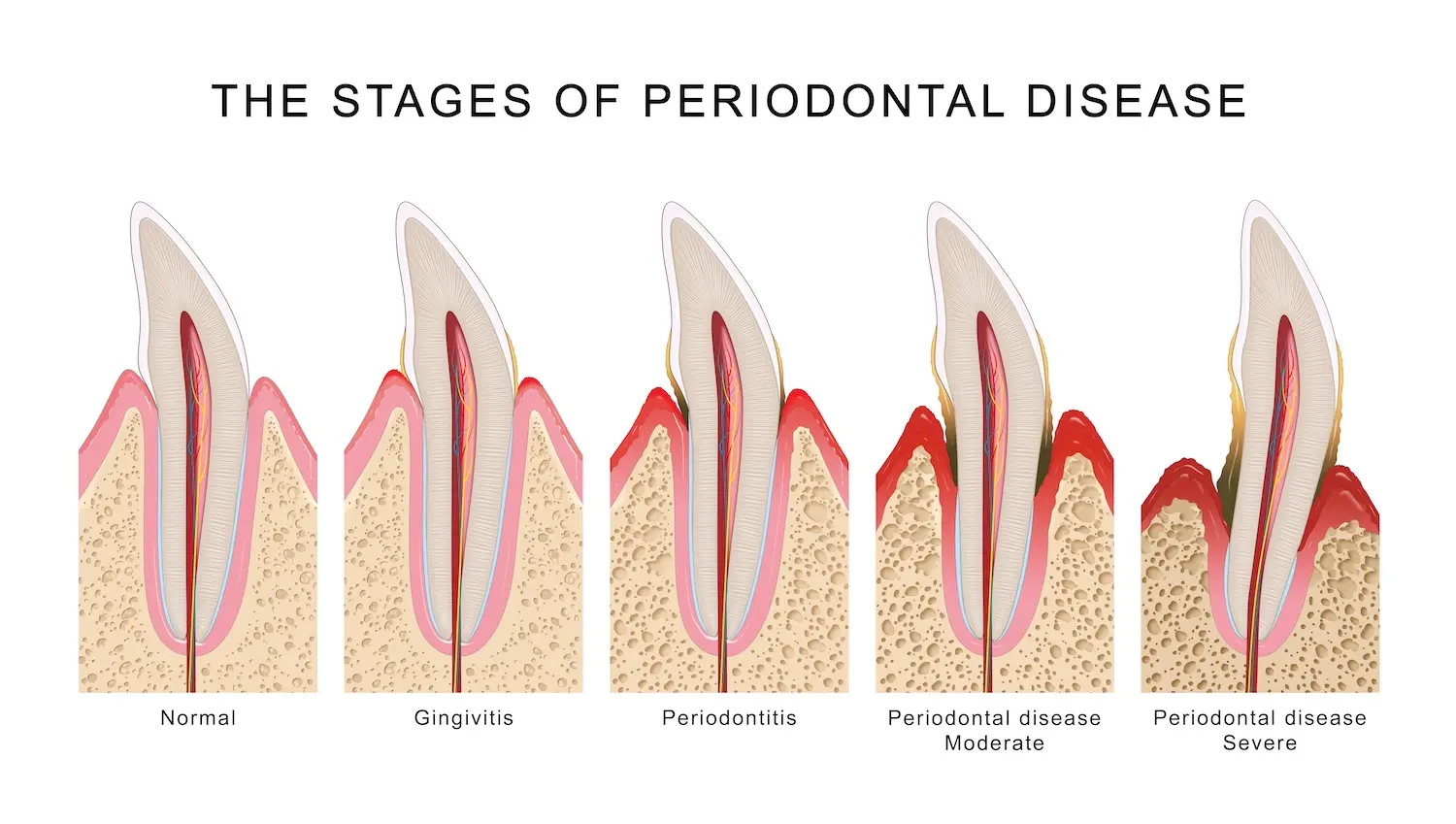Common Causes of Swollen and Bleeding Gums
Swollen gums and bleeding gums often represent the initial manifestation of inflammation within the periodontal tissues. This condition is primarily caused by the accumulation of dental plaque and calculus, which harbor colonies of pathogenic bacteria. These bacteria trigger an inflammatory response in the gum tissue, resulting in swelling, redness, and bleeding. Several other factors may exacerbate gum inflammation, including:
Brushing too aggressively or using a toothbrush with hard bristles.
Hormonal changes, such as during pregnancy.
Vitamin C deficiency (scurvy).
Side effects of certain medications (e.g., antihypertensives or anticonvulsants).
Systemic conditions like uncontrolled diabetes mellitus.
Gingivitis: The Early and Reversible Stage of Gum Disease
Gingivitis is the mildest and most reversible form of gum inflammation. It occurs as a biological response to chronic irritation from plaque and calculus along the tooth surface. Clinical signs of gingivitis include:
Gums appearing red, swollen, and bleeding during brushing.
Soft and tender gum texture.
Occasional bad breath or mild discomfort.
Although seemingly mild, gingivitis should not be ignored. With professional dental care, such as scaling, and consistent oral hygiene at home, this condition can be fully reversed without damaging the supporting tooth structures.
Periodontitis: When Gum Infection Becomes More Serious
If gingivitis remains untreated, the inflammation can progress into periodontitis, a more advanced stage of periodontal disease. At this point, infection has spread to the deeper supporting structures of the teeth, including the periodontal ligament and alveolar bone.
Common signs of periodontitis include:
Swollen gums accompanied by spontaneous bleeding.
Loose or shifting teeth.
Pain while chewing or pus discharge between the gums.
Gum recession, making the teeth appear longer.
Damage occurring at this stage is often irreversible without timely intervention. Treatment typically involves deep scaling (root planing), periodontal curettage, or advanced laser-assisted periodontal therapy to eliminate bacteria beneath the gum line.

Warning Signs of Periodontal Disease
Some symptoms indicating that periodontal disease has advanced include:
Bleeding gums without an obvious cause.
Receding gum line exposing more of the tooth surface.
Persistent bad breath despite proper brushing.
Tooth sensitivity, looseness, or shifting.
The presence of these signs requires immediate evaluation by a dental professional, particularly a periodontist.
The Systemic Impact of Periodontal Disease
Chronic periodontal disease such as periodontitis is not merely an oral health issue—it can also influence systemic health. Prolonged inflammation may release inflammatory mediators into the bloodstream, increasing the risk of several chronic diseases, such as:
Coronary heart disease and stroke.
Poorly controlled diabetes mellitus.
Pregnancy complications, including preterm birth and low birth weight.
Therefore, maintaining healthy gums contributes directly to overall systemic well-being.
When to See a Dentist
Schedule a professional dental examination if you experience:
Bleeding gums persisting for more than three consecutive days.
Swollen gums accompanied by severe pain or pus discharge.
Loose or shifting teeth.
Persistent bad breath that doesn’t improve.
Your dentist will perform a comprehensive periodontal assessment, professional scaling, and—if necessary—advanced periodontal treatments to restore gum health.
Conclusion
Swollen gums and bleeding gums should never be taken lightly, as they are early signs of gum inflammation and potential periodontal disease such as gingivitis or periodontitis.
By maintaining optimal oral hygiene, undergoing professional scaling regularly, and consulting your dentist for early intervention, you can prevent infection progression and preserve the integrity of your tooth-supporting tissues.
Healthy gums are the foundation of a strong, aesthetic, and long-lasting smile—reflecting Onyx Dental Center’s commitment to high-standard dental care focused on long-term oral health excellence.
References
Könönen, E., Gursoy, M., & Gursoy, U. K. (2019). Periodontitis: A Multifaceted Disease of Tooth-Supporting Tissues. Journal of Clinical Medicine, 8(8), 1135. https://doi.org/10.3390/jcm8081135
Mehrotra, N., & Singh, S. (2023). Periodontitis. In StatPearls [Internet]. Treasure Island (FL): StatPearls Publishing. Available fromhttps://www.ncbi.nlm.nih.gov/books/NBK541126/

